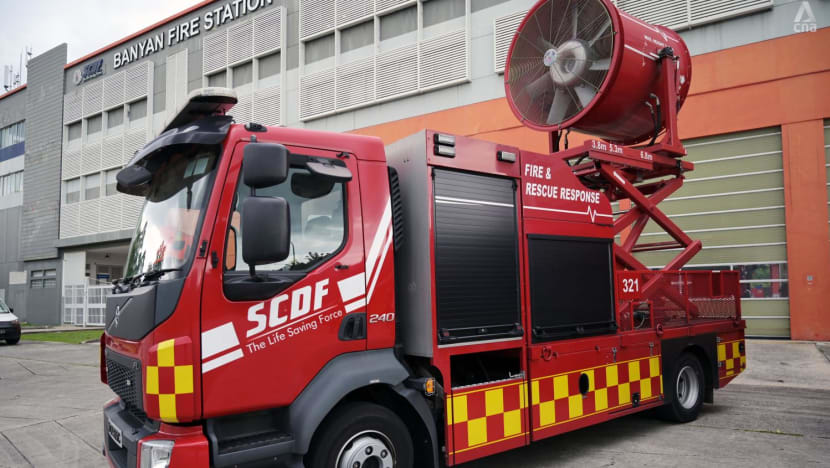Modular oil tank firefighting system is SCDF’s latest tool in fighting large-scale fires
The Singapore Civil Defence Force held a media showcase in the lead-up to the 11th edition of Exercise Northstar, which will take place next week.
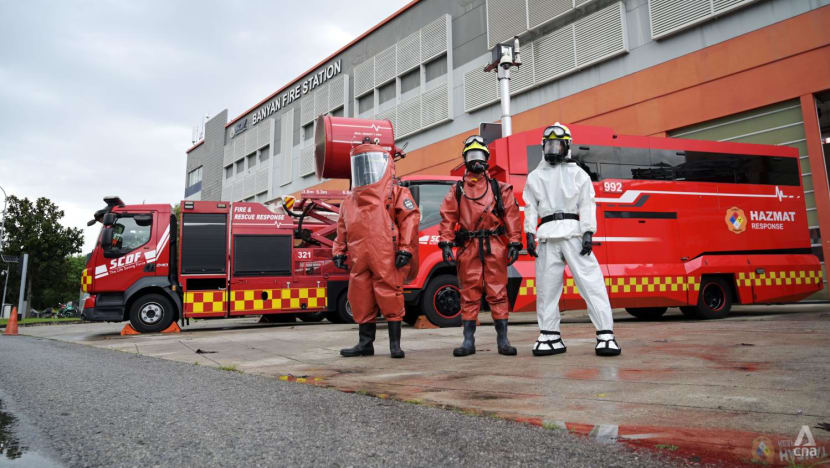
(Photo: CNA/Marcus Mark Ramos)
SINGAPORE: If you have modular furniture at home that you rearrange to suit your needs, you may be surprised to find you have something in common with the Singapore Civil Defence Force (SCDF).
Much like how home owners can build their sofas or bookshelves in varying combinations, the components of SCDF's latest-generation oil tank firefighting system – such as water pumps and large monitors – can be put together in different ways to combat large-scale oil storage tank fires.
SCDF’s new system also can discharge up to 100,000 litres of foam solution per minute, equivalent to filling up an Olympic-sized swimming pool within 25 minutes – a significant increase from up to 60,500 litres per minute.
Last month, members of the media were invited to Banyan Fire Station on Jurong Island to check out SCDF's capabilities in the lead-up to Exercise Northstar XI, which will take place on Mar 22.
The multi-agency terrorism exercise, to be held on Jurong Island this year, will test government agencies’ responses to a crisis.
The last edition took place at Changi Airport in 2017 and has previously been held at locations like the Singapore Sports Hub.
This year’s exercise will begin with a terrorist attack leading to explosions of multiple IED (improvised explosive device) explosions. In turn, this will cause a chemical pipeline rupture and two large oil tank fires.
In response to the scenario, SCDF will send in its modular oil tank firefighting system as well as its full suite of hazardous material (HazMat) capabilities.
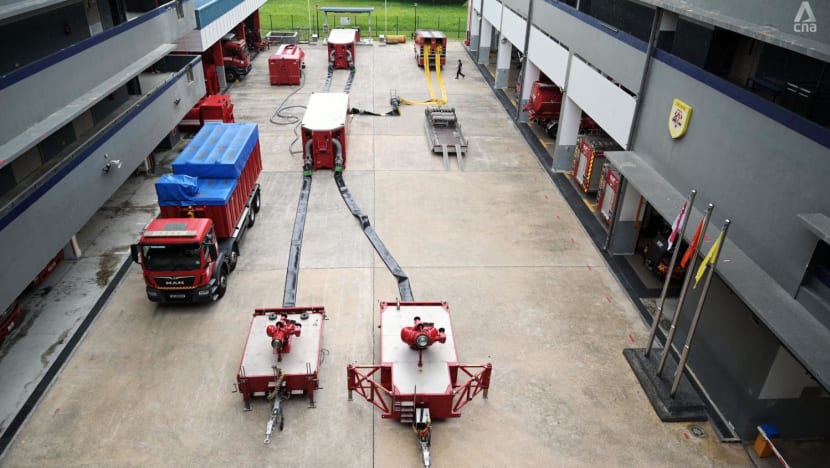
MONITORS WITH HIGHER CAPACITIES
In the past, SCDF had two monitors – which dispense water or foam at high capacities – to mitigate large-scale oil tank fires. These were deployed to fires at 23 Tembusu Road on Jurong Island in 2016 and Pulau Busing in 2018.
Now, the modular oil tank firefighting system features monitors that can pump out more foam, allowing SCDF to better fight fires involving larger oil tanks.
One monitor can be connected to a booster pump unit, which serves as the nerve centre of the system where important parameters such as water flow and pressure are controlled.
The booster pump unit can then be connected to a submersible pump unit or a collecting manifold.
The former collects water from an open water source like the sea and supplies it to a pump placed up to 60m away, while the latter allows SCDF’s 12-inch hoses to connect to 5-inch industrial ring mains, which are what Singapore stipulates for companies to provide on their premises.
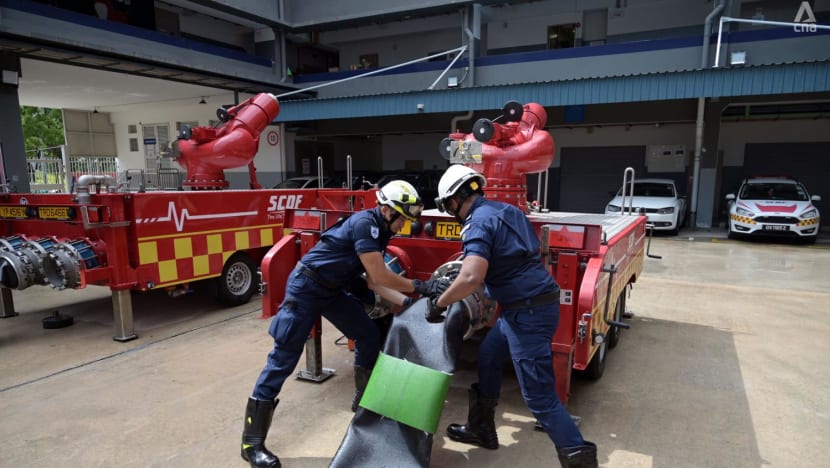
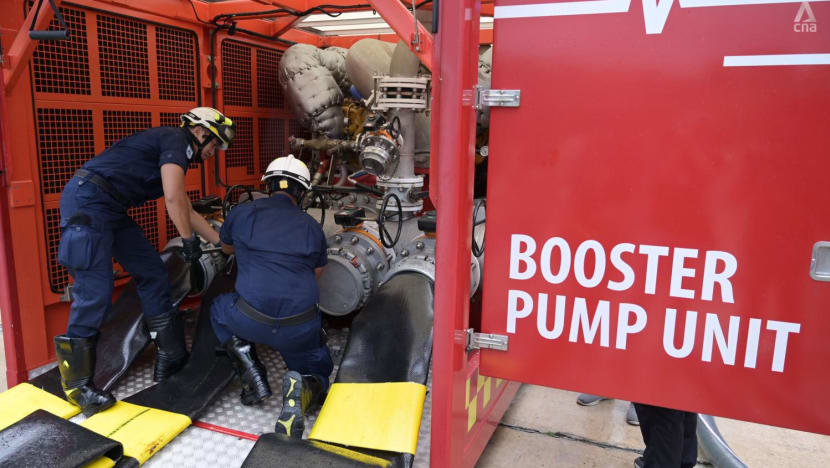
In addition, SCDF can cut down on the number of monitors it deploys because the new monitors are larger-volume ones – up to 80,000 litres per minute, as compared to 22,700 litres per minute, for an individual monitor.
"This allows the SCDF to rapidly intervene and mitigate oil tank fires of up to 112m in diameter," said Colonel Mohamed Firoz Ramjan, commander of the 1st SCDF Division.
Through the use of 12-inch hoses with the new system, SCDF officers can also lay hoses on the ground in a neater and more systematic fashion.
This delivers the same water rate as before, when a smaller number of hose lines were required to run the older system.
The modular oil tank firefighting system's pod-on-vehicle concept also means that its various components can be easily transported on pod carriers to other offshore islands via the use of barges.
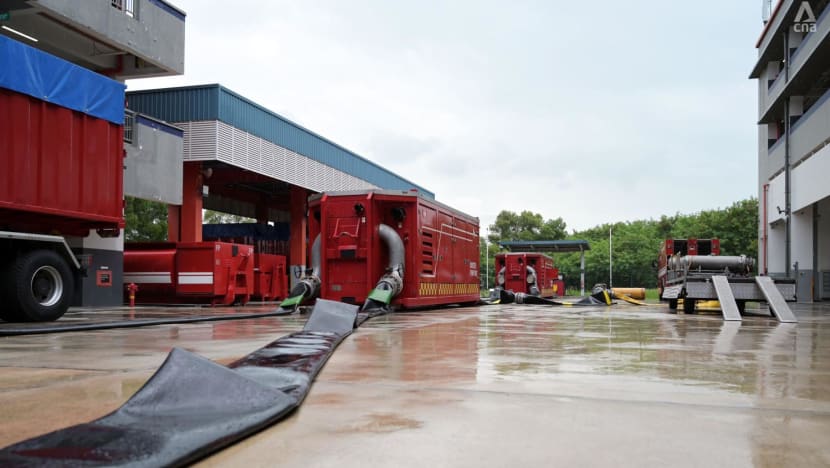
TACKLING HAZARDOUS MATERIALS
SCDF also showcased different personal protective equipment (PPE) that responders wear during HazMat incidents, along with vehicles and its robotic dog that can be deployed in chemical plants.
The PPE to be worn depends on the hazardous substance involved and the environment the responders will be operating in.
For example, the light decon suit is a disposable lightweight suit to protect SCDF officers in decontamination operations.
It provides 24 hours of protection in liquid and vapour-hazard areas, and responders get constant airflow through a gas mask with canisters attached to a powered air-purifying respirator on a belt.
Another high-performance suit with self-contained breathing apparatus has an airtight design and is resistant to acids, alcohols and bases, among other hazardous materials.
It can resist temperatures of at least -40 to 60 degrees Celsus for normal use, and up to 100 degrees Celsius for shorter periods.


Among the vehicles that SCDF will roll out during Exercise Northstar is the HazMat Control Vehicle, which helps to identify hazardous substances, assess the extent of contamination and determine the mitigation approach.
Colonel Shaiful Herman Shali, director of SCDF's HazMat department, told reporters: “(It has) the latest in terms of equipment and technology to detect and identify hazardous substances.
“Within this vehicle, we also have standoff detection capabilities, which allow us to visualise and detect chemicals that may be up to 5km away. This is very important in terms of early warning capabilities.”
The HazMat Control Vehicle, which is currently in its third generation, also has an unmanned aerial vehicle launch pad and analytical equipment for the identification of hazardous substances.
The HazMat Incident Management System that is within the HazMat Control Vehicle enables SCDF officers to conduct wide-scale monitoring during a hazmat incident.
Wall-to-wall monitors in the vehicle can track the air quality in an area, for instance. The system can also aggregate sensor data from various agencies.
It was jointly developed by SCDF, the Home Team Science and Technology Agency, the Defence Science and Technology Agency and DSO National Laboratories.
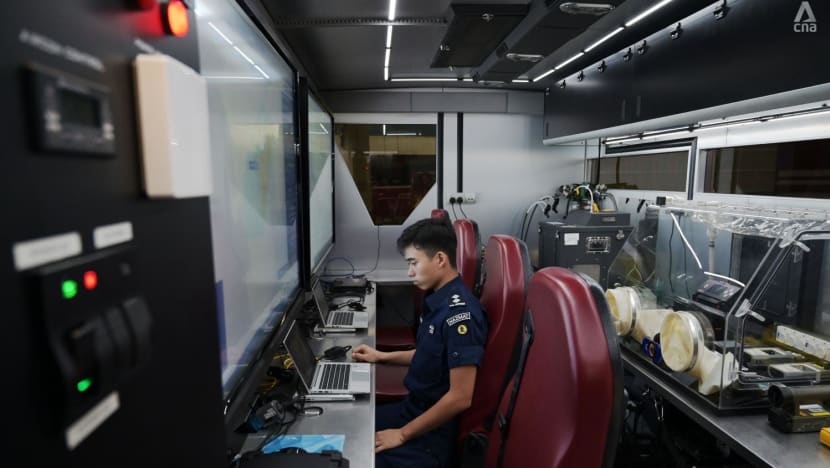
The Ventilation Vehicle, which was introduced in 2004, can disperse chemical plumes during a HazMat incident and help to combat fires in areas like highway tunnels and industrial areas where ventilation may be limited.
Hoses can also be connected to the vehicles to provide water mists.
SCDF has two such ventilation vehicles at Ang Mo Kio Fire Station and Marina Bay Fire Station, where highway tunnels are close by.
Col Shaiful said: "We will also have, on-site, our HazMat specialists who are trained and well-equipped to mitigate all types of HazMat leaks and scenarios. With all these capabilities and competencies, we will be able to keep Singapore safe."
